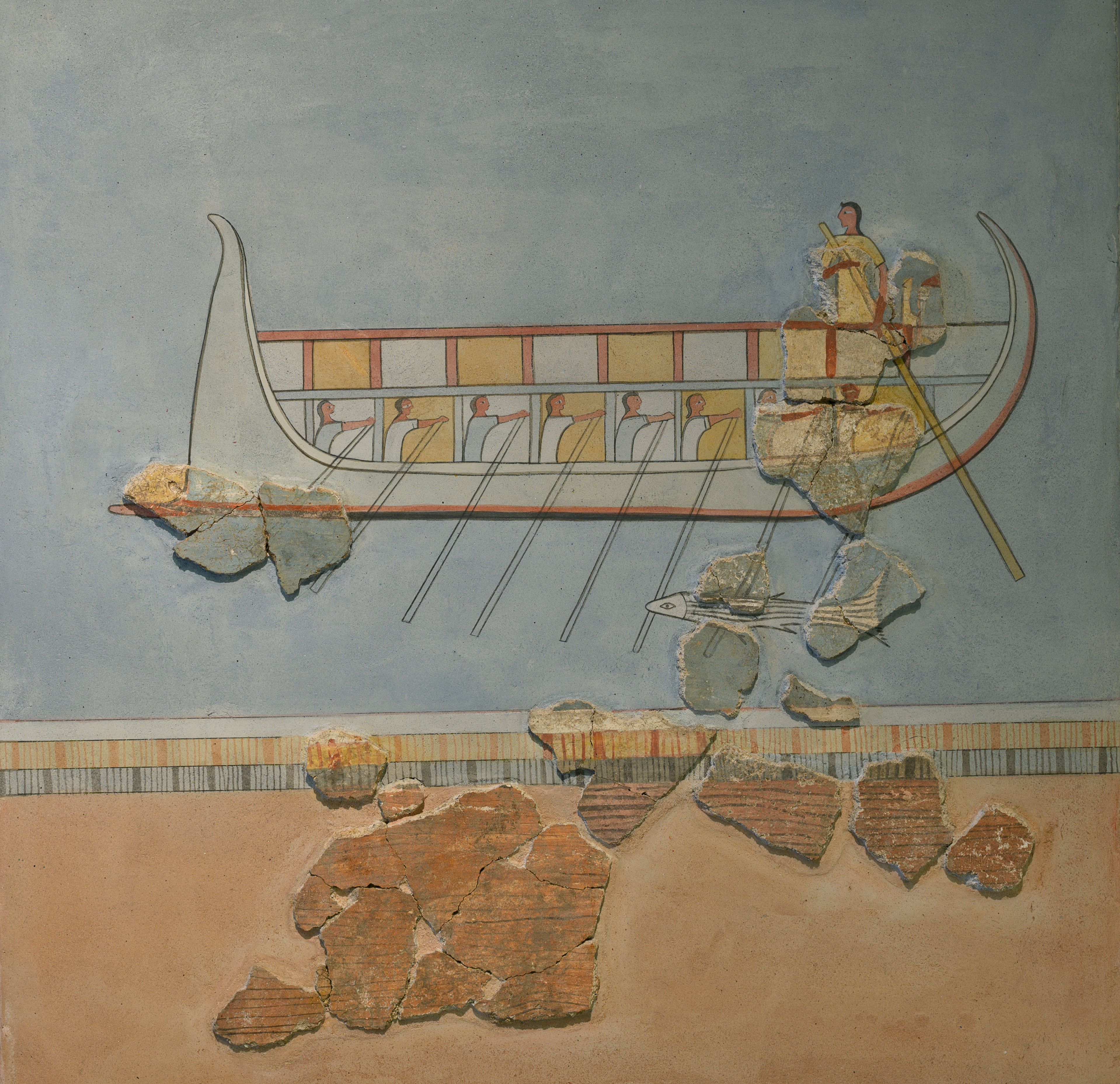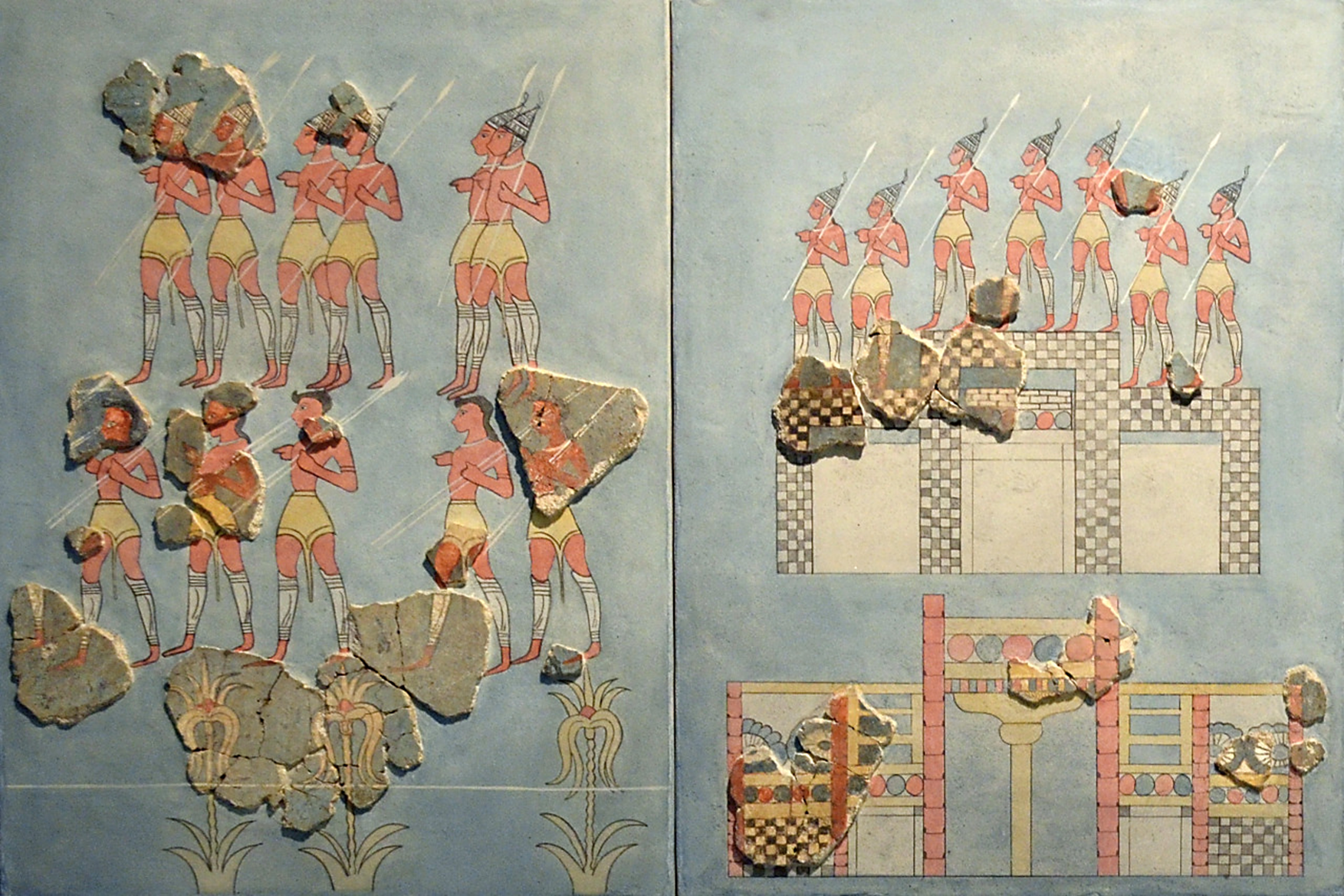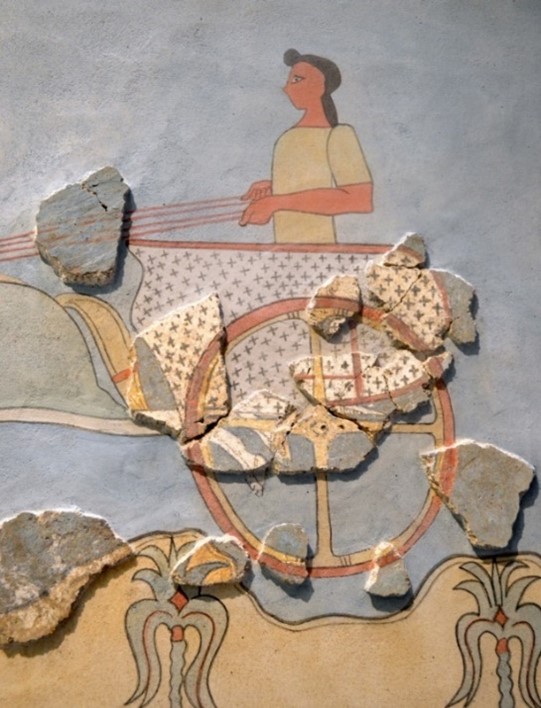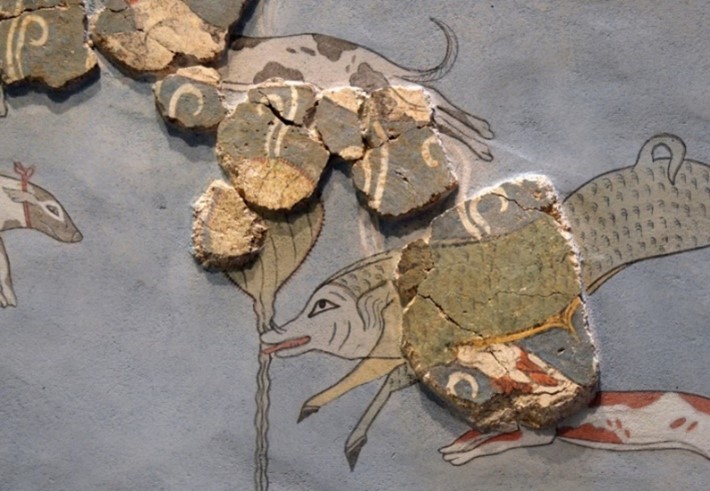Ship to the left against a blue background, with a fish swimming below. Surviving fragments show part of the stern and bow (?). Gunwale rendered in white, keel line in red, and hull in blue. Two figures facing right seated in separate rectangular cabins row to the left, holding the oars in their outstretched hands and plunging them into a blue sea. They are dressed in outfits of alternating colours (white and blue from right to left). The cabin background behind them also alternates, between yellow and white from right to left. The roof and supporting poles of the rower's rooms are rendered in blue. Above them is a second superstructure amidships (awning ?) with divided compartments whose beams are rendered in red, while the background alternates between blue and yellow. A helmsman facing left stands on top of this second superstructure, clothed in yellow and holding a yellow steering oar. Three additional fragments appear to show parts of the keel line. The proposed reconstruction suggests these are at the bow and show a flat keel line that continues into a bow projection beyond the base of a vertical stempost. The yellow background behind the hull on this crucial fragment is problematic.
Naval fresco fragments
A3
LH IIIB
Orchomenos
n/a
polychromatic fresco fragments
Thebes Archaeological Museum
Aravantinos and Fappas 2015: 324, n. 29; Boulotis 2015: 372; Tournavitou 2017: 98; Vlachopoulos 2015 : 56
Orchomenos is generally accepted as a palatial site, having a megaron and a tholos tomb (Treasury of Minyas) which was stylistically similar to the Treasury of Atreus at Mycenae (Alcock and Cherry 2006). Known structures include the main palace or Men's Megaron (southern side of the plateau, 8 x 40m, divided into three rooms with a large ovoid hearth), and the Little Palace or Queen's Megaron (on the northern side of the plateau, 4x20m, tripartite division) which follows the architectural plan of the palace-complex at Tiryns. The Little Palace was built at the end of LH IIIA (c.1335) over layers of older EH and MH buildings (Spyropoulos 2003). The entire complex was heavily damaged by an earthquake early in the 13th century, after which it was rebuilt and remained in use until the end of LH IIIB:2 (c. 1180)(Spyropoulos 1974). It has been argued that the palatial authority of Orchomenos shifted its center of power to Gla in LH IIIA:2/LH IIIB:1, with Orchomenos remaining an important ancestral center and burial ground (Knodell 2013: 165-166; Maggidis 2014). The main maritime outlet of Orchomenos/Gla was probably Larymna, which was built in LH IIIB. It was fortified and had minimal access to agricultural land, indicating that it was built for the explicit purpose of providing a port facility for a large polity (Kramer-Hajos 2008: 129). Contemporaneous with the construction of Gla, the drainage of Lake Kopais towards the end of the 14th century (LH IIIA:2) represents a large-scale engineering project of enormous proportions which transformed the Kopais basin (ca. 20 000 ha) into the most expansive and fertile agricultural plain of mainland Greece. The artificial drainage of the submerged marshland was achieved through the means of a complex drainage control system which required the diversion of six rivers and streams from the basin into two wide peripheral canals which converged at Gla, in the northeastern edge of the Kopais basin. These possibly navigable artificial canals "were flanked by massive watertight embankments (2 m high and 30 m wide) which were reinforced in places with double Cyclopean revetments bearing roads on their crowns, and were supplied with underground drains and channels leading the water overflow into artificial polders, natural bedrock cavities and sinkholes, or to the bay of Larymna."(Maggidis 2014). The building of the dykes and massive embankments on either side of the canals running for many kilometers around the periphery of the basin involved moving an estimated 2,000,000 cubic meters of earth and 250,000 cubic meters of stone.
Context: The Little Palace has provided fragmentary wall paintings excavated by Bulle and Spyropoulos belonging to at least three distinct pictorial compositions: 1) a miniature boar hunt scene comparable to that known from Tiryns; 2) a cult scene showing a grove where young attendants bring offerings to priests dressed in long robes, possibly part of a miniature composition; 3) a Flotilla-type scene that includes an architectural façade (palace or town) with soldiers standing atop, marching warriors, parts of chariots, possible falling or swimming figures, and an oared ship.1 With the exception of the cult scene which is associated with an inner room of the north wing of the complex,(Spyropoulos 2015: 364-366, figs. 18-22) the remainder of the material cannot be connected to a specific primary context, although the boar hunt was discovered by Spyropoulos in the immediate vicinity of the monumental complex (Spyropoulos 1973a; 1974; 2015). In the course of conservation and restoration in the Archaeological Museum of Thebes, a miniature scene of a ship with rowers was found with fragments of the miniature hunting scene. The fragments thus possibly come from an adjacent wall of the same room, and may belong to the composition with architectural façades that was found by Bulle (Bulle 1907: 72-74, pl. XXVIII). If correct, the ship was probably either approaching or departing from a city in a similar fashion to the Akrotiri fresco. Arvantinos and Fappas claim that a common original provenance for all of these fragments is very likely, but note that those from the old German excavations and those recovered in the 1970s were located approximately 175 m from each other. The former were found scattered in debris,(Bulle 1907: 71) while the latter lay beneath floor levels.
Influences: The Orchomenos fragments provide the closest parallel
from the mainland of the much earlier narrative ship frescoes (West
House of Thera, Hagia Eirene on Kea), with the obvious iconographic
affinities being especially intriguing in light of their late date. The
influence of Minoan wall-painting on Mycenaean art is
well-established (Chapin 2010). A general decline in quality from LH IIIA to LH
IIIB contexts has been interpreted by Brysbaert as a potential hint of
Minoan craftsmen being directly involved in the earliest Palatial wall
painting but not in later ones (Brysbaert 2008: 2761). Brysbaert furthermore points to the
similarities in production techniques between Thebes, Orchomenos and
Gla, which raise the possibility of itinerant craftsmen (Ibid). Boulotis
furthermore notes that Theban and Boeotian frescoes more generally share
strong thematic and stylistic similarities with those of the major
Argolid centers, which suggests a special relationship between these two
areas as well as the presence of artists instructed in a shared
pictorial tradition which was ultimately of Minoan origin (Boulotis 2000: 1103-1105). This
relationship is most discernible in pictorial scenes with a common
thematic content such as the boar hunting scenes from Orchomenos and
Tiryns, while the automated manner in which repetitive subjects of
composite decorative borders are depicted hints as specific workshops
active in both regions.
1. Interpreted by Boulotis as a siege theme (Boulotis 2000).
It is unfortunate this ship is still unpublished. If correct, the proposed reconstruction would be extremely significant as it would be the only example of a galley being shown in this medium. Caution is warranted however, especially since the stern fragments make the ship very similar to those from Pylos, which are of the Minoan vessel type (Wedde type IV) with a crescentic hull. The presence of superstructures and the positioning of the helmsman otherwise do not make sense, as these never occur on galleys. The rendering of the ship with alternating colors, the position of the rowers, their placement in separate rooms and the superstructure amidships are all aspects which this composition shares with earlier naval frescoes.
Aravantinos, V. and I. Fappas. 2015. “The Mycenaean Wall Paintings of Thebes: from Excavation to Restoration,” in H. Brecoulaki, J. L. Davis, S. R. Stocker (eds.) Mycenaean Wall Painting in Context: New Discoveries, Old Finds Reconsidered. ΜΕΛΕΤΗΜΑΤΑ 72. Athens: National Hellenic Research Foundation / Institute of Historical Research, pp. 316-354.
Boulotis, C. 2015. “Reconstructing a Dolphin Frieze and Rgonauts from the Mycenaean Citadel of Gla,” in H. Brecoulaki, J. L. Davis, S. R. Stocker (eds.) Mycenaean Wall Painting in Context: New Discoveries, Old Finds Reconsidered. ΜΕΛΕΤΗΜΑΤΑ 72. Athens: National Hellenic Research Foundation / Institute of Historical Research, pp. 371-403.
Tournavitou, I. 2017. The Wall Paintings of the West House at Mycenae. Prehistory Monographs 54. Philadelphia: INSTAP Academic Press.
Vlachopoulos, A. 2015. “Detecting “Mycenean” Elements in the “Minoan” Wall Paintings of a “Cycladic” Settlement: The Wall Paintings at Akrotiri, Thera within their iconographic Koine,” in H. Brecoulaki, J. L. Davis, S. R. Stocker (eds.) Mycenaean Wall Painting in Context: New Discoveries, Old Finds Reconsidered. ΜΕΛΕΤΗΜΑΤΑ 72. Athens: National Hellenic Research Foundation / Institute of Historical Research, pp. 37-65.








